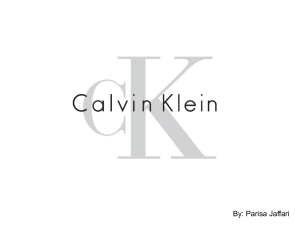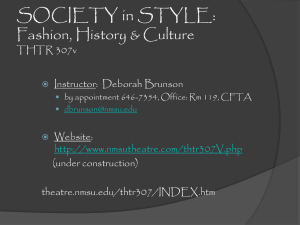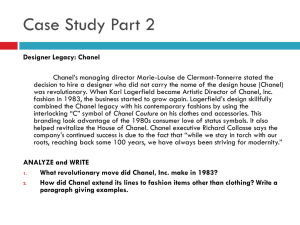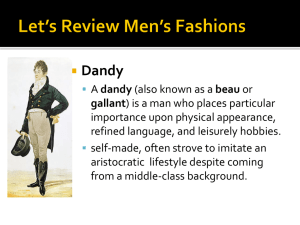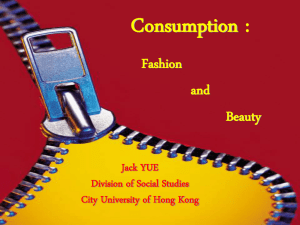Income
advertisement
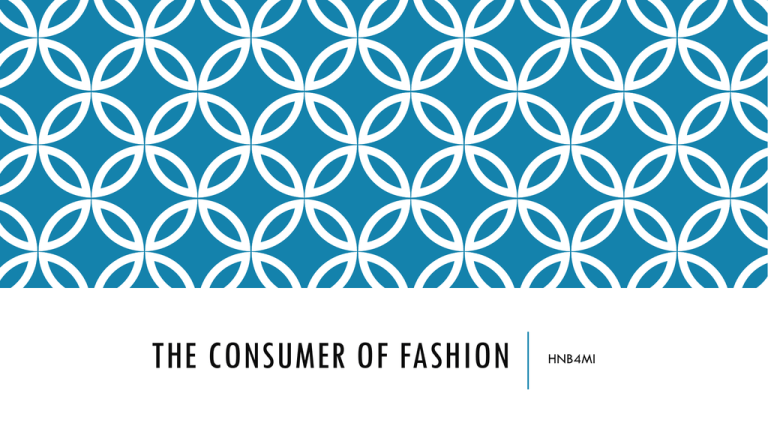
THE CONSUMER OF FASHION HNB4MI PRODUCT DEVELOPMENT Clothing is typically designed and produced with a specific target customer in mind. Knowledge concerning what the customer eats, where they live, what they drive, where they holiday, etc. and how these habits relate to their lifestyle and value system is relevant and essential information when designing and producing apparel. MARKET SEGMENTS There are many different types of fashion consumers, separated by a variety of characteristics: Age Occupation Income Education Lifestyle By separating consumers into segments, fashion producers and retailers are able to make more reliable and economical decisions about what to offer their customer. Both demographics and psychographics are used by professionals to gather and analyse consumer data to assist them when making business decisions. DEMOGRAPHICS INCLUDE: A FOCUS ON OBJECT CHARACTERISTICS OF A POPULATION Age: Fashion designers, manufacturers, producers and retailers ensure their styles cater to a specific age group. Occupation: Apparel is being produced which is suitable for workplace attire, expanding career dress departments. Education: Individuals with higher formal education earn substantial incomes, education determines one’s income level and therefore influences their apparel needs. Income: Socioeconomic status and social class impact price point and merchandise quality. Two income households have higher incomes. Geographic Location: Where one lives affects clothing needs; environmental and climate changes contribute to clothing choices. Population: Fashion manufacturers study population distribution to see if there is an abundance of any particular age group in a particular area. If there is a high birth rate than there is a need for infant clothing. FAMILY LIFE CYCLE People are categorized according to their place in the family life cycle and is another means by which fashion producers and retailers determine customer needs. Each stage in the life cycle is met by different clothing needs. Review the Family Life Cycle in Relation to Clothing Needs and Resources for a better understanding. PSYCHOGRAPHICS INCLUDE: A FOCUS ON SUBJECTIVE STUDY OF A POPULATION’S CHARACTERISTICS A psychographic study will typically isolate a consumer group's motivations to buy or consumption patterns by considering: Personality Ethnicity Attitudes Life style Interests Opinions For example, when considering age and consumer needs, not all female twenty year olds are the same. Some twenty year old women are raising a family, while others are working, and still others are involved in post secondary education. The fashion needs and discretionary income of each of these specific groups is very different. CONSUMER BUYING MOTIVES Price Quality Label/Prestige Some reasons for buying a product are rational and others can be emotional. Fashion merchandise has the ability to appeal to an individual's emotional motives for buying, especially when status and prestige are connected to the product Some consumers purchase clothing based on quality, durability of material, laundering method, and price point. Such considerations are termed rational motives. As well, this consumer is not influenced by trends but rather by the way the garment looks and fits the body. Designer names and labels do not influence this consumer. Retailers who offer private label merchandise cater to this market segment as do manufacturers who specialize in knockoffs SOCIAL INFLUENCES ON A FASHION CONSUMER: Mink Rath, Bay, Petrizzi, & Gill (2008, pg. 188) have defined social influence as: . . . the information or pressure that an individual, group, or type of media presents or exerts on consumers. SOCIAL CLASS: In relation to fashion, one of the major social influences is social class or socioeconomic status (SES). Studying and understanding the values and characteristics of the different social classes is yet another tool by which to target one's customer. Canadian and American population is categorized into: upper, middle, and lower classes. (can be subdivided into more specific groupings) Social class is hierarchical and often depends on level of opportunity and prosperity. In fashion, each class exhibits specific clothing behaviour. For example, the upperupper class who have inherited their wealth, dress in a very understated and elegant manner. Cost, trendiness, and visible labels are not important to this consumer group. In contrast the lower-upper class counterpart; they are referred to as the nouveau riche (new rich) and although cost may not be important, the label is everything. Diamond & Diamond (1997). THE AVERAGE CANADIAN CONSUMER: Most Canadians fall into the middle class. For the purpose of marketing is segmented into the upper-middle class and lower-middle class. Such segmentation is important because each segment exhibits different consumer and spending behaviours. For example, although the upper-middle class prefer designer labels and fashion forward merchandise (Diamond & Diamond, 1997, pg. 71), they will also shop at off price stores such as Winners and T.J. Max. FURTHER EXAMPLES: Donna Karan satisfies this consumer group with her DKNY line as does Perry Ellis with the Perry Ellis Portfolio line. Isaac Mizrahi followed suit with his Isaac label as did Giorgio Armani with his Mani label. These lines pay attention to silhouette and garment design yet are lower priced, thus satisfying this group's cautious nature towards money and appetite for status labels. SOCIAL CLASS CONTINUED The lower-middle class purchasing behaviour tends to focus on merchandise of lesser quality. This consumer group purchases mass produced items while the upper-middle class purchases both RTW and mass produced apparel. The lower class is again divided into the upper-lower class and the lower-lower class. Upper – Lower Class = price is extremely important and hence clothing purchases are typically made at value discount retailers such as Wal-Mart, Zellers, and off price stores. This consumer group purchases fashion items, these purchases are made when the fashions have reached their lowest price. This consumer group is also the target for the Shopping Channel where inexpensive, lower quality items are available. Lower-lower class = survival over fashion; clothing is purchased out of necessity rather than want or desire. FASHION AND CONSUMER RESEARCH: Research Process: 1. Identify the Problem: develop and define the problem, refine the problem; often the problem is written as a question. 2. Data Collection: Data may be gathered from two possible sources; primary sources and secondary sources. Typically in the fashion industry, secondary sources are examined first, as this approach is more cost effective. Secondary data are typically available from the following sources: Company records and archives including sales reports, price point analyses, product returns, etc. Government agencies such as Statistics Canada Trade associations such as the Canadian Apparel Association Periodicals such as Style (the Canadian trade publication) and Women's Wear Daily, WWD (the American trade publication). RESEARCH PROCESS CONTINUED: Questionnaire: The questionnaire method collects data via personal interview, telephone interview, or by mail. The method used is dependent on market size and location, and how quickly a response is required. When developing a questionnaire the following must be considered: The length of the form should be brief, 5 minutes to complete Appropriate language must always be used. Avoid the use of slang and technical language. Specific language, not general language should always be used. Avoid words such as usually and generally. Questions should contain a single idea. In other words avoid asking two questions together. Avoid developing questions which will give only a yes or no response. This information is not useful. Questions should be ordered in a sequential manner so that there is a flow from one question to the next. Whenever possible provide choices for possible answers so that the data collected does not require interpretation. Always include demographic questions. Always provide specific directions. OTHER METHODS: Focus Group The focus group method collects data by recording information from a small group or panel of people (ten to fifteen people). This data collecting method is becoming more popular as it produces reliable results for manufacturers, fashion producers, and retailers. Typically the focus group will evaluate promotions and advertising campaigns, customer service, addition of a fashion item to the store's merchandise mix, addition of another manufacturing line such as knockoffs, etc. and their responses are recorded or videotaped. The important part of using focus groups is the composition of the group and the competence of the recorder/moderator. OTHER METHODS: Observation Through the observation method one can make some judgments about consumers' fashion preferences. The fashion section of a newspaper will often report on who wore what to a major event. Manufacturers and fashion producers will often use the observation method to conduct fashion counts which determine what people are wearing. For example, a count that focuses on women's skirts may find that women are wearing shorter skirts with a straight silhouette than longer skirts. A manufacturer may decide to conduct a count that focuses on colour direction. RESEARCH PROCESS CONTINUED: 3. Sampling: Once you have determined the appropriate methodology for your study, you must determine the number of responses you require in your sample and the sampling technique you will employ. It is essential that the sample selected be truly representative of the market group being studied. The different sampling techniques used by researchers are as follows: Random Sampling: This sampling technique means that every individual in a predetermined group has an equal chance of being selected. Non-random Sampling: This sampling technique is similar to random sampling except the sample is restricted. For example, you may choose to collect data from retail establishments who sell merchandise at a price point of greater than $800.00. Area Sampling: This sampling technique might restrict data being collected from retail establishments which fall within a predetermined boundary. Once the sampling selection has been determined the data collection process can begin. RESEARCH PROCESS CONTINUED: 4. Data Analysis: Once data has been collected it is analyzed, summarized, and conclusions are drawn. It is imperative that the data be tabulated and analysed without bias. Data analysis is an extremely important step in the research process because the conclusions drawn from such an analysis will determine the direction in which the manufacturer, fashion producer, or retailer wishes to move. Because costly business decisions are made based on the analysis of the data, a report is typically written which outlines all the stages of the study and possible options. Charts, graphs, and other supporting materials are typically included in such a report.


